We all have seen cars. Most of us even drove one. But, do you know what cars are made of? Their parts, location, and function? When we get something new, we always read the instructions to learn how it operates and what is it made of. Why should it be different with cars?
I know, in order to get your driving license you need to pass an exam about the traffic rules and to actually know how to drive. But, it is also important to know the parts of the car, maybe even perform a quick fix when the car stops on the road and help is far away.
I will do my best to provide as many details and information as I can in this article. Below is a table of contents so you can jump to the part that interests you.
Car Engine Bay Parts
The engine is the heart of the vehicle. If you are not a mechanic, opening the hood and looking at the engine can be very confusing. But, once you learn a thing or two about how the engine works, you will put together the whole picture, puzzle by puzzle.
Alternator
The alternator has the main function supply the vehicle with electrical energy by converting the mechanical energy coming from the crankshaft and recharging the car battery.
The alternator is an essential item because a car battery doesn’t have the ability to recharge itself. It can only run for 15-30 minutes and then your car will turn off.
That’s where the alternator comes into place. As fuel is taken from the fuel tank into the engine and combustion occurs, the crankshaft gets moving power which is transferred to the alternator by the serpentine belt. The alternator takes that ‘moving’ or mechanical power and powers a magnet and a copper wire coil that transforms the mechanical energy into electrical energy.
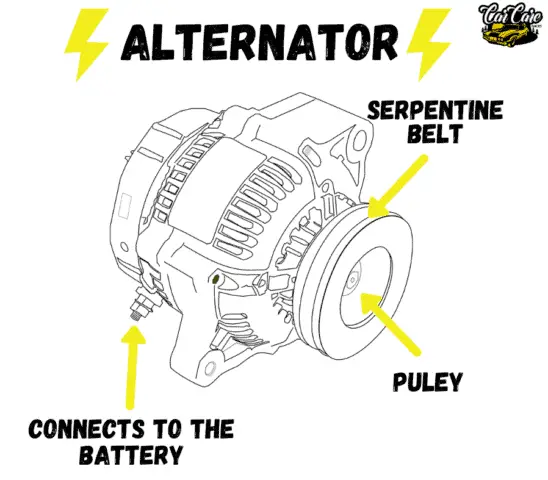
See: What Are The Symptoms Of A Bad Alternator?
I think that now you have the full picture of the importance of the alternator and why you must always have a functioning alternator. If you cannot start your car on your own, but you can do so by jump-starting it, you might want to look into the battery or the alternator.
A full replacement of the alternator will cost from $500 to $1000.
There are 5 types of alternators:
- Vehicle Alternators
- Diesel-electric Locomotive Alternators
- Marine Alternators
- Brushless Alternators
- Radio Alternators
Battery
The car battery has the main function to store electrical energy and to supply the starter with power in order to start the vehicle. The battery also provides electrical energy to the radio, lights, and other car components driven by electricity.
See: What Drains A Car Battery While It Is Off?
Please note that when the vehicle is turned off, the battery can supply the car with electricity for a certain amount of power. Usually, you could listen to your radio for an hour before the battery is completely drained. When you turn your vehicle on, your battery will be recharged thanks to the alternator.
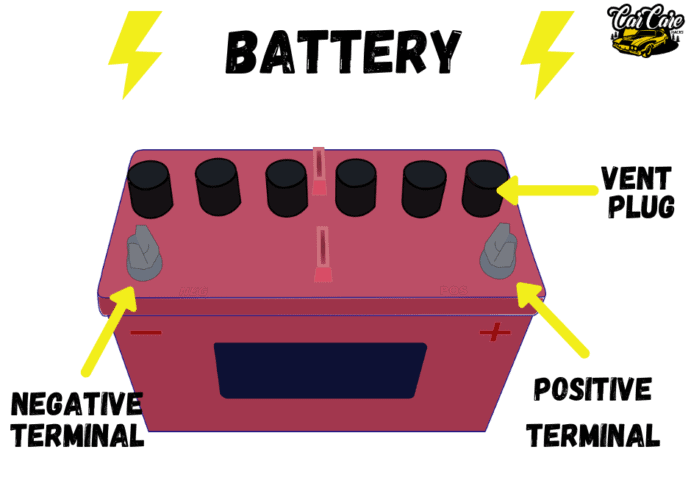
If your car is constantly losing power you might need a new battery. A brand-new battery costs anywhere between $50 and $200.
Most of the vehicles use starting, lighting, and ignition batteries.
Clutch
The clutch has a function to transmit the torque from the engine into the drive-train. Basically, the clutch enables smooth vehicle movement by delivering the power from the engine to the drive-train. Also, the clutch reduces drive-related vibrations.
The clutch itself is located on the rear side of the engine and is attached to the flywheel, and the clutch pedal is located on the floor of the car, on the left far side.
It can be found only on cars with manual transmissions. The cars with automatic transmissions have a built-in clutch that is not visible from the cabin. Replacing a clutch can cost anywhere from $1000 to $1400.
There are 9 types of clutches:
- Single plate clutch: Mostly used on modern light vehicles.
- Multi-plate clutch: More clutches mean more friction surface, therefore, more capacity to transmit torque.
- Cone clutch: The friction surfaces are in a shape of a cone(2 of them).
- Centrifugal clutch: Uses centrifugal force to keep the clutches in engaged position.
- Semi-centrifugal clutch: This clutch uses a centrifugal force only to transmit torque at a higher speed engine. For regular speed, the clutch uses levers and clutch springs.
- Dog and spline clutch: The two shafts are locked in with external teeth and sliding sleeves with internal teeth on a so-called ”dog” lock.
- Electromagnetic Clutch: The torque is transmitted mechanically, but the clutch operates electrically.
- Vacuum clutch: This type of clutch uses a vacuum in the engine manifold that operates the clutch.
- Hydraulic clutch: Same as the vacuum clutch. The only difference is that the hydraulic clutch uses oil pressure to operate instead of a vacuum.
Radiator
The main function of the radiator is to prevent the engine from overheating by constantly circulating coolant in tiny metal hoses all around the engine that takes the heat from the engine and then cools the fluid with a fan before sending it back again.
If the car radiator is clogged or is leaking, the coolant will not be able to take the heat from the engine which will result in engine overheat. Basically, a small hole which can be repaired easily can cost you new engine.
How Do You Do A Coolant Flush? – Complete Guide

A brand new radiator can cost anywhere between $290 and $1200.
There are 2 types of radiators:
- Aluminium Radiator: Used for high performance cars. Both body and the tank are made from aluminium.
- Plastic and Aluminium Radiator: Mostly used in newer model cars. The body is made from aluminium and the tank is made from plastic. It is the cheapest to produce.
- Copper and Brass Radiator: Manufacturers stopped making this type of radiator in the 1980s. They ran into a lot of issues because the copper is expensive and corrodes.
Radiator Fan
The radiator fan has a main function to supply cooling air to the engine through the grille and to cool down the hot coolant that is circulating around the engine and taking his heat before it is released back into circulation.
Basically, once the coolant completes a circle around the engine it is hot. Then, the coolant stored into the radiator where the fan cools it down before it is sent for another ‘cooling’ lap.
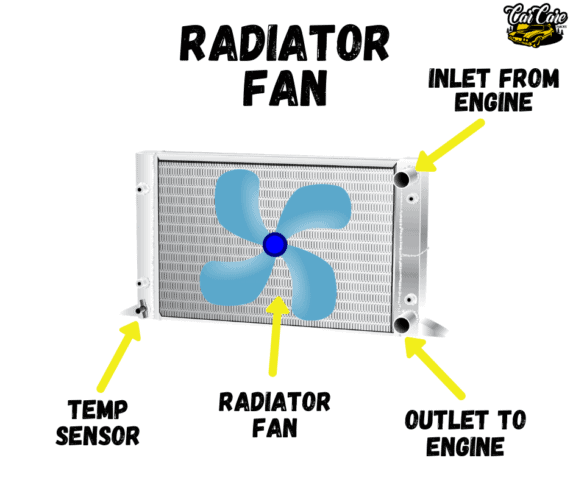
This being an important part of the cooling system, you must always have an operating radiator fan. A replacement of the radiator fan can cost around $300 to $520.
See: How To Cool Down Overheating Engine Fast
There are 2 type sof radiator fans:
- Mechanical Radiator Fan: Mostly used in older models. This type of radiator fans have a built in switch which allows the fan to stop cooling when the engine is cold.
- Electric Radiator Fan: Found in newer vehicles. Operated by the engine computer.
Timing Belt
Timing belt is a reinforced rubber band that has a main function to connect the engine crankshaft to the camshaft in such a precise order that each time the car starts running, the timing belt is set in motion and it will turn the camshaft which will open and close the engine valve’s allowing the pistons to move up and down. This is a very precise operation and there is no room for error.
If your timing belt starts producing squeaking noises, it is definitely time to change it. A brand new belt costs between $500 to $900. But, if not changed on time, it can break and cause damage that will cost you up to $2000.
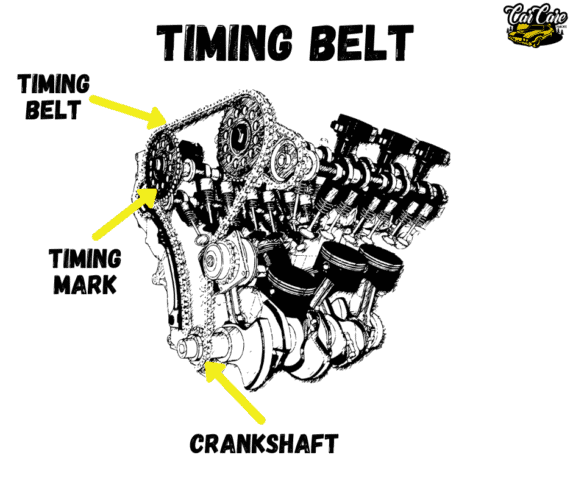
The timing belt comes in metric and imperial dimensions. Check your manufacturer manual to see which size timing belt your car is using.
Spark Plug
Main function of the spark plug is to create a spark between two leads with a small gap between them that ignites the air/fuel mixture which creates an explosion that starts your engine.
The number of the spark plugs will depends on the number of cylinders. Example: V6 engine will have 6 spark plugs.
The spark plug has a lifespan of around 100,000 miles. After that, you will need around $40 to $150 to change your spark plug.

There are 4 types of spark plugs:
- Copper Spark Plug: Has a shorter lifespan but offers high performance because of the copper’s high conductivity.
- Platinum Spark Plug: Longer lifespan than copper ones. Used in newer vehicles, has a great temperature resistance.
- Double Platinum Spark Plug: Have a longer lifespan. Check your manual to see this type of spark plugs is recommended.
- Iridium Spark Plug: Stronger than platinum, lasts 25% more. Famous for working under extreme conditions.
- Double Iridium Spark Plug: Can lasts up to 4x longer than the standard copper spark plug.
Fuel Injector
As a primary fuel delivery system, the fuel injector is a small nozzle with a main function to spray fuel at high pressure into the combustion chamber of the internal combustion engine.
The fuel injector is a replacement for the carburetor.
The average replacement of the fuel injector can cost between $800 and $1450 depending on your car model.
There are 4 types of fuel injectors:
- Single-Point Fuel Injection: The grandfather of fuel injection. Not so precise.
- Multi-point Fuel Injection: Has a separate nozzle for each cylinder.
- Sequential Fuel Injection: Sprays fuel in same time.
- Direct Fuel Injection: Injects fuel directly into the combustion chambers, bypassing the valves.
Transmission
The main function of the transmission is to transfer the power generated from the engine to the drive shaft and rear wheels. The transmission has different gears which dictate the speed of your vehicle as well as the moving direction.
If you notice that your transmission is starting to fail, a complete replacement could cost from $1800 to $3400.
There are 4 types of transmissions:
- Manual Transmission: At this type of transmission, the driver has to select each gear manually by moving the gear box and applying the clutch.
- Automatic Transmission: Here the driver has to select a driving direction. Example: If you select D on your gear stick the car will move forward and all of the gear will be changed automatically. You just have to press the gas pedal.
- Automated Manual Transmission: This type of transmission has an clutch built in which is controlled by a computer. You can choose to shift the gears manually or automatically on the gear stick.
- Continuously Variable Transmission: Has no clutch, instead it uses belts and pulleys. Offers optimum power range and efficiency.
Car Air Conditioning
The main function of the car air conditioning system is to supply the passenger cabin with cool air through the AC vents as well as to filter the air and remove the moisture from the air before it reaches the cabin.
Your AC needs refrigerant in order to produce cold air. If your AC stops blowing cold air, it doesn’t mean that the AC is broken, it could be low on refrigerant.
See: How To Get Your Car’s AC Ready For Summer
I usually add refrigerant every 2 years because I don’t use the AC very often. It costs around $200 to recharge my car AC.
Car Parts: Fluids
This section is about fluids needed in order for the car to run smoothly.
Engine oil
The engine oil main function is to lubricate, protect, cool, seal, reduce friction and clean all the moving parts within the engine. The engine oil is located in the bottom oil pan under the engine, but before it reaches the oil pan, it circulates the engine.
Without the engine oil, the motor will not run. That being said, it’s important to check your engine oil levels. To do so, you need to locate the oil dipstick. The oil dipstick has a yellow handle with ‘oil’ engraved on it and can be found in the engine bay.
See: How To Change Your Engine Oil – Beginners Guide
There are 4 types of engine oil: Full synthetic motor oil (great for vehicles that demand high level performance and lots of lubrication), synthetic blend motor oil (can be used for high performance and daily drive and its cheaper than full synthetic), conventional motor oil (most used motor oil for your daily) and high mileage motor oil (used for cars that have over 75,000 miles under their belt).
Transmission Fluid
The transmissions fluid main function is to lubricate, clean and protect all the components of both manual and automatic transmissions. The transmission fluid is located in the transmission fluid pan.
Before it reaches its main destination, the transmission fluid circulates and lubricates all the transmission components. When it comes to changing the transmission fluid, there is a bit controversy. On many cars, it says that the transmission fluid is good to go for decades, or as long as you are using your car.
But, myself and many other people who know what they are talking about recommend that you change it every 4-5 years. I mean, no fluid or oil can be good after 10,15 or 20 years. You can check your transmission fluid levels by checking the yellow dipstick with engraved text ”ATF or MTF” that is located in the engine bay.
There are 6 types of fluids that you can use to lubricate your transmission:
- Dexron/Mercon (these are the most used fluids for automatic transmissions)
- HFM Fluids (same as the dexron and Mercon, but even more effective
- Synthetic Fluids (these cost more but are made to endure on drastic temperature changes)
- Type-F (this type is used for automatic transmissions, mostly on older models)
- Hypoid Gear Oil (this one is used for manual transmissions, it’s very effective)
- Motor Oil (usually it the motor oil is for the engine itself, but, you can use it to lubricate your manual transmission as well).
Power Steering Fluid
The power steering fluid main function is to lubricate and protect all of the components of the steering system. The PS fluid is a specially designed hydraulic fluid that runs through the steering mechanism and makes your steering wheel to turn with ease. The power steering fluid is located in a power steering fluid reservoir, under the hood (usually on the passenger side).
There is a steering wheel icon on the reservoir cap, so it’s easy to locate. There are markings on the side of the PS reservoir which tells you if your power steering fluid is low or full.
Many mechanics suggest that you change your power steering fluids before it hits 100,000 miles. If you notice that your steering wheel is harder to turn left and right, you could be experiencing a PS leak, or simply the PS fluid is no longer effective and need to be changed. The power steering fluid should have a light brick color.
If you notice that your PS fluid is darker, change it. There are different types of power steering fluids. Many cars use the same fluids as the transmission fluids (Dexron, Mercon, Type F, ATF, Hypoid Gear Oil, Synthetic Fluids, etc), but there are also fluids specially designer for the power steering system which many newer models use.
Coolant or Antifreeze
The coolant (or antifreeze) main function is to protect the engine components from freezing in the winter as well as balancing the engine temperature by removing the heat, especially in the summer. The coolant/antifreeze is located in a reservoir under the hood, in most cases on the passenger side.
The coolant/antifreeze reservoir has markings on the side that will tell you the level of your coolant. If your coolant level is low, you need to pour some. In order to do that, you need to open the radiator cap and add until it fits no more. This fluid is very important. As, I said before, it regulates the engine temperature. If you are low on coolant and you add water, the water will evaporate and your engine will overheat.
There are 3 types of coolant/antifreeze: IAT (Inorganic additive technology which is used by older models), OAT( Organic acid technology which is used by newer models) and HOAT (Hybrid organic acid technology which is a enhanced version of OAT). The changing intervals of the coolant/antifreeze is 5 years or 50,000 miles. This is of course if you don’t have a faulty cooling system.
You should always perform visual inspections to see the condition of the coolant/antifreeze. There are two colors: green and orange. If your coolant is not in those colors, you should perform a coolant flush and change your coolant. If your coolant reaches a low level before the changing intervals, make sure to inspect if your cooling system is leaking and fix it.
Brake Fluid
Brake fluid is a hydraulic fluid that is used for transferring force into pressure in hydraulic brake and hydraulic clutch applications. Simply said, when you press the brake pedal, the brake fluid changes the force of your foot on the brake pedal into pressure that is distributed to the front and rear brakes and makes the car stop. The brake fluid is located in the brake fluid reservoir under the hood on the driver’s side of the vehicle.
The reservoir has markings on the side that will show you the level of your brake fluids. Trust me, you do not want to be low on brake fluid. Many mechanics suggest that you change your brake fluids every two years, or if the color changes from light yellowish to dark.
The brake fluids are designed to have a high boiling point. If the brake fluid has a low boiling point and it boils, it will become gas and will lose the ability to transmit force.
There are 3 main types of brake fluid:
- DOT3 (glycol-based, absorbs water from air)
- DOT4 (also glycol-based, absorbs water from air)
- DOT5 (sylicon-based, does not absorb water). It is important that you always keep your brake fluid reservoir closed and tightly sealed.
Car Parts: Filters
Without the filters, we would spend more time at the mechanic than driving the car. Imagine if your car has no fuel filter and all the dirt from the fuel gets into the engine? How far would you get?
Oil Filter
Oil filter main function is to remove all dirt, debris and other contaminants from the engine oil so your engine can have clean oil circulating.
As the engine runs, overtime, little metal parts fall off and circulate through the engine along with the oil and are eventually caught up by the filter. Depending on the vehicle model, the oil filter can be located under the engine or on the top of the engine.
The oil filter is usually changed when you change your engine oil. A quality oil filter costs anywhere from $7-$25. Although the oil filters look almost the same, there are small differences in the threads or the gasket size. It is important that you check your manufacturer manual before buying one.
There are 6 types of oil filters:
- Full-flow filter: The most commonly used oil filter. Works great in colder temperatures.
- Secondary oil filter: Some car models have a secondary oil filter as a support to the main oil filter.
- Cartridge oil filter: These filters are mounted upright and can be visually inspected without removing it.
- Spin-on oil filter: Type of full-flow filter that is very easy to install.
- Magnetic oil filter: It is mostly used as a secondary oil filter. It does a great job at removing metallic contaminants, but not so much dust and grime.
Fuel Filter
Fuel filters have a vital function in the fuel system. The main objective of the fuel filter is to prevent all of the impurities from the fuel, such as dirt, rust and other contaminants from getting into the fuel system and eventually into the engine.
The fuel filter is usually located on the fuel line, somewhere between the tank and engine.
It’s hard to tell the lifespan of an fuel filter because it depends on the clarity of the fuel. I usually change the fuel filter every time i change my engine oil. A high quality fuel filter costs anywhere from $14 to $60.
Manufacturers offer 2 types of fuel filters: Spin-on fuel filters (has excellent work-ability because the entire metal case can be replaced and Cartridge fuel filters (only the filter itself is changed).
Air Filter
The air filter has a main function to prevent debris from the environment getting into the engine and compromising the engine health.
You can only imagine how much debris get caught up in the air filter. A dirty or clogged air filter can affect your fuel economy as well as the acceleration. The lifespan of air filters is 15,000 to 30,000 miles, but I always change it when i change my engine oil and filter. A decent air filter costs anywhere from $20 to $50. The car air filter is located under the hood in a cold air collector box.
There are 3 types of air filters:
- Paper Air Filters: These are the most commonly used air filters because of the low price.
- Gauze Air Filters: Long lasting and cleanable air filters. They require maintenance every 5000 miles.
- Protective Foam Air Filters: Mostly used by small engines. They have an extra layer of protective foam that keeps pollutants away from the combustion system.
Cabin Air Filter
Cabin air filter main function is to filter out the air coming from the air conditioning before it is released into the cabin. It keeps all the dust, dirt, pollen, bacteria and other contaminants that are bad for the human health. The fact that you are breathing a clean and fresh air inside the cabin, it’s because of the cabin air filter.
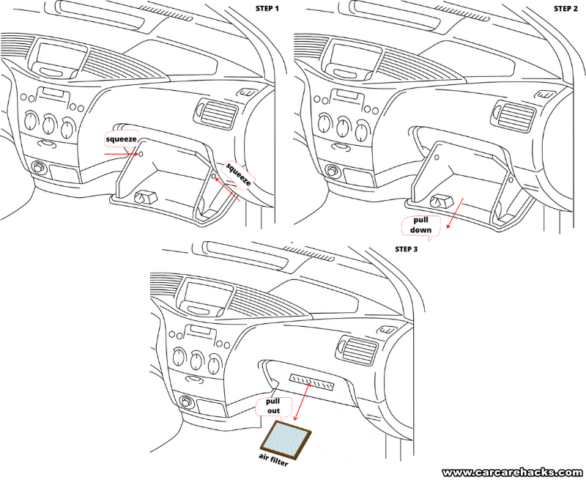
You do need to have a clean cabin air filter at all times, but what you don’t need is mechanic skills to locate and change it yourself. The cabin air filter can be found in the glove box compartment. In order to find it, you need to open your glove box, pull the glove box door all the way down and you will see a plastic cover with ”cabin air filter” markings on it. A cabin air filter costs around $15-$25.
See: All You Need To Know About Cabin Air Filter
There are 4 types of cabin air filter:
- Particulate cabin air filter: Even though it traps 0.3 microns and larger contaminants, it does not trap odors and gaseous pollutants.
- Charcoal cabin air filter: This filter can remove odors and smoke as well as microscopic bacteria.
- Activated carbon cabin air filter: Great at filtering odors and other gaseous contaminants as well as microorganisms.
- Electrostatic cabin air filter: Uses static charge to capture pollutants. Great at removing odor, smoke and dust.
Interior Car Parts
This section is dedicated to all the items that can be found inside the cabin.
Steering Wheel
Steering wheel’s main function is to turn the front wheels left and right as the driver applies rotational commands to the steering wheel. The driver’s rotational commands pass through series of joints and other components of the steering system before finally reaching the wheels. The steering wheel is located in the cabin. It can be found on both left and right side. You can find a decent steering wheel starting at $100.
There are 6 types of steering wheels:
- Tilt steering wheels: Mostly used in luxury cars because it has a highly adjustable features that can make any driver drive comfortably.
- Telescope steering wheels: Only the height can be adjusted at this type of steering wheel.
- Adjustable steering wheels: Same feature as the telescope steering wheels, but uses electric motors for height adjustment.
- Swing-away steering wheel: These type of steering wheel can be adjust for up to 9 inches to the right.
- Recirculating ball steering wheels: Used by many trucks and SUVs.
- Rack-and-Pinion steering wheels: The most commonly used steering wheels in cars after 2010.
Airbags
The airbags are a safety feature that have a main function to minimize injury and even prevent death when an accident happens by inflating with air and stopping the passengers from hitting any hard surface.
The airbags are deployed when your car hits something and decelerates fast. But the airbags will not deploy every time we hit something. How does it know when exactly to deploy?
Whenever we hit something our car decelerates very fast. There is a chip called accelerometer that measures the change of speed and if the change of speed is great enough it will deploy the airbags.
There are more than one airbag in your vehicle. I am sure that you noticed the writing on your steering wheel or above the glove box.
Car AC Vents
Car AC Vents have a function to blow the cold air coming from the air conditioner into the passenger cabin therefore maintaining a cool and enjoyable temperature. The ac vents are connected directly to the air conditioner. Before the air enters the cabin, it passes through the cabin air filter which cleans the air before it releases it in the passenger cabin.
The car AC vents are located on top of the dashboard facing the windshield, on the driver side right behind the steering wheel, in the center console and on the passenger side. Ac vents can also be found in the back of the car, usually on doors.
Car Seats
Car seats provide comfort and security of the driver as well as the passengers. The car seats function is to keep you comfortable by providing back support as well as keeping you in one position while you drive. Car seats come in many forms. They can be racing seats, sport and tuner seats, suspension seats and classic seats. They cost anywhere from $50-$500.
It is very important that you adjust your car seats before driving. The car seats come with a mechanic or electric adjustment.
On the mechanic car seats, there should be a metal bar in front bottom of the car seat that you can use to push the car seat back and forth as well as a handle on the side of the car seat for back adjustment.
On the electric car seats, there are buttons located on the left side of the car seat that provide the same features as the mechanical car seat, plus more(height).
The car seats can be in different materials such as: Nylon, leather, polyester, vinyl and faux materials. Newer car models also have car seat heaters that are very handy in the winter.
Rear View Mirror
The rear view mirror allows the driver to see whats behind him making him more aware of his surroundings. The rear view mirror is especially useful when you are overtaking vehicles and parking in reverse. I always use the rear view mirror to see if there are any cars behind me on the highway, just in case i need to perform an emergency brake.
The rear view mirror is located inside the cabin in the middle of the windshield. It is highly adjustable which makes it easy for all drivers. The newer models come with a camera mounted on the rear view mirror for even more awareness of your surroundings. The rear view mirror can cost anywhere from $4-$650.
Car Seat Belt
Car seat belts are design to save a persons life in an accident. Basically, the car seat belt is wrapped around your body and when an accident occurs, the seat belt will hold your body strapped to the car seat and will prevent you from hitting your head on the steering wheel or eventually flying out o the car in a roll-over accident.
The car seat belts are located next to each car seat. The driver and all passengers have an individual car seat. It is illegal to drive without your car seat belt on. If your car seat belt is worn, you need to replace it immediately. The replacement of a car seat belt can cost you between $20-$85.
There are 6 types of car seat belts:
- Lap style car seat belt: This is the first type of seat belt. It wraps around the waist of the person.
- Sash type car seat belt: This type of car seat belt goes around the person’s shoulder and is tightened on the waist. Proved to be very bad.
- Lap/Sash: A combination where the seat belts goes around the persons shoulder and waist.
- Inertia reel: This is the most commonly used car seat belt. With it’s three-point design it goes around the shoulder, chest and pelvis.
- Belt-in-seat: This type of car seat belt is safer in rollover crashes.
- Five-point harness: The five point harness car seat belt is used at race cars and high performance vehicles.
Gas Pedal
The gas pedal also known as the accelerator, controls the amount of air that is being released into the engine which is connected to the electronic throttle control which makes sure that enough fuel is being burned to control the air-fuel ratio. In another words, the gas pedal controls the speed of your vehicle.
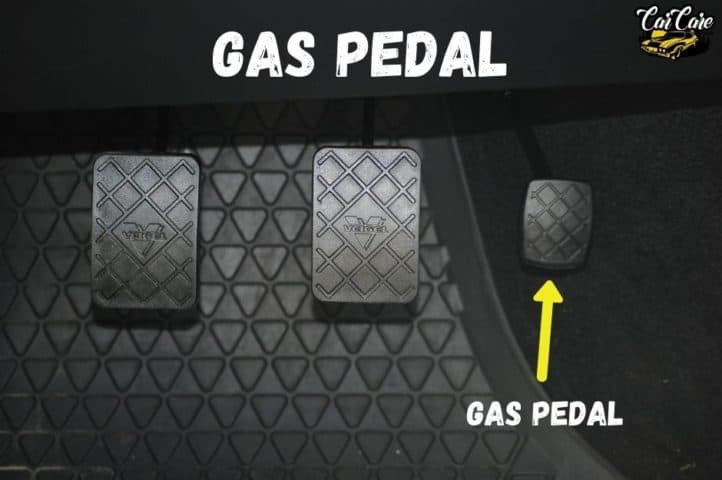
The gas pedal is located on the the floor on the far-right, next to the brake. In a disabled people’s car, the gas pedal can be located on the left side on the floor or behind the steering wheel as push/pull lever.
A brand new gas pedal costs anywhere from $50-$120 depending on your car model and make.
Ignition Key
The ignition key main function is to start your car as well as to turn it off. When you put the ignition key in the ignition cylinder and you turn it to the right, the key is transmitting a signal to the transponder circuit which is coded to tell the engine to start. The ignition key is also used to lock and unlock your car.
An ignition car key costs anywhere from $50 for a basic key to over $500 for more advanced type of key.
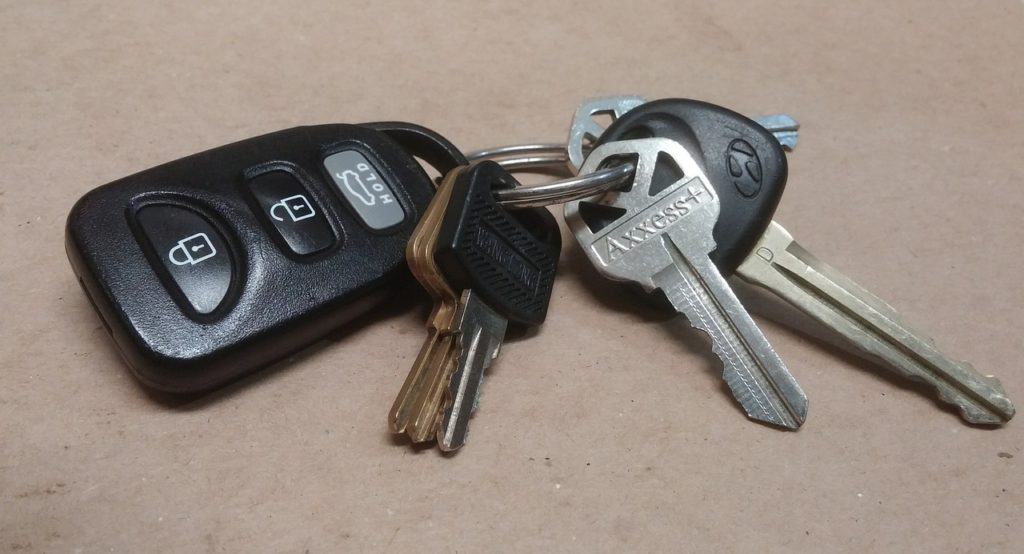
There are 9 types of ignition keys:
- Basic car key: Used in older model cars. Easy to copy with easy to non security features.
- Remove control car key: Produced after the basic key. Has a remote lock-unlock feature.
- Car key transponder: Has an electronic transponder chip in the key which has one unique code. If the code doesn’t match with the code installed to the car, the engine won’t start.
- Car key transponder with rolling codes: Has a series of unique codes to start your car.
- Switchblade car key: The part of the key that goes into the ignition cylinder can be folded.
- Smart car key: Designed by Mercedes-Benz. Does not have the usual metal sticky part that goes into the ignition cylinder. It looks more like an UBS.
- Master car key: Mostly used by car dealerships to program replacement car keys.
- Valet car key: It looks like a credit card. The key just needs to be near the car in order to lock/unlock and start the car.
Gear Stick
The gear stick is a metal lever which role is to change the gears on your vehicle. Gear stick, also called gearshift or shifter, is connected to the shift assembly, so anytime you change the gear into lower or higher, it corresponds with the transmission and changes the gear.
The gear stick is usually found between the driver’s and passenger seat, on the center console. Some older model vehicle’s have a gear stick right next to the steering wheel.
The manual gear stick has markings which are R for reverse, and the other are gear numbers from 1 to 6 depending on the vehicle.
The automatic gear stick has markings with: R for reverse, P for parking or e-brake, N for neutral and D for drive. Newer models will also have markings such as S for sport or C for comfort.
Car Dashboard
The car dashboard, also called dash or instrument panel is located in front of the driver and it’s function is to display instrumentation and control of your car’s operation.
In another words, it gives you an overview of all the vehicle’s operations going on at the moment. If something is wrong with your vehicle, the dashboard is the first place to look because it will show an error code.
Replacement of your car dashboard can cost you anywhere from $50 to $500 depending on your car make and model.
The car dashboard is equipped with gauges such as:
- Fuel gauge which tells you the current fuel level.
- Engine temperature which tells you the temperature of your engine.
- Speedometer which shows you your current speed
- Odometer tells you how many miles or kilometres your vehicle has.
- Warning lights: If there is something wrong with your vehicle, a warning sign will pop up on the dashboard. On some models you will get a text, on some just an icon. Most common is the check engine light.
Horn
The horn with its ”honk” or ”beep” sound is used to warn other drivers or to get someone’s attention on the road. Mainly, it is used to express unsatisfactory while waiting for the red light to turn green. The horn is located on the front side of the steering wheel which makes it very accessible.
A horn replacement can cost anywhere from $140 to $160 with labor included.
There are two types of car horns: Disc and fanfare horns. The disc horn has that metallic sounding beep and the fanfare horn produces more richer sound.
Glove Compartment
Glove compartment or glove box is a compartment built in the dashboard located in front of the front seat passenger and is used to store important items from the vehicle such as manufacturer manuals, license and insurance as well as some other items that you would need at hand while in your vehicle.
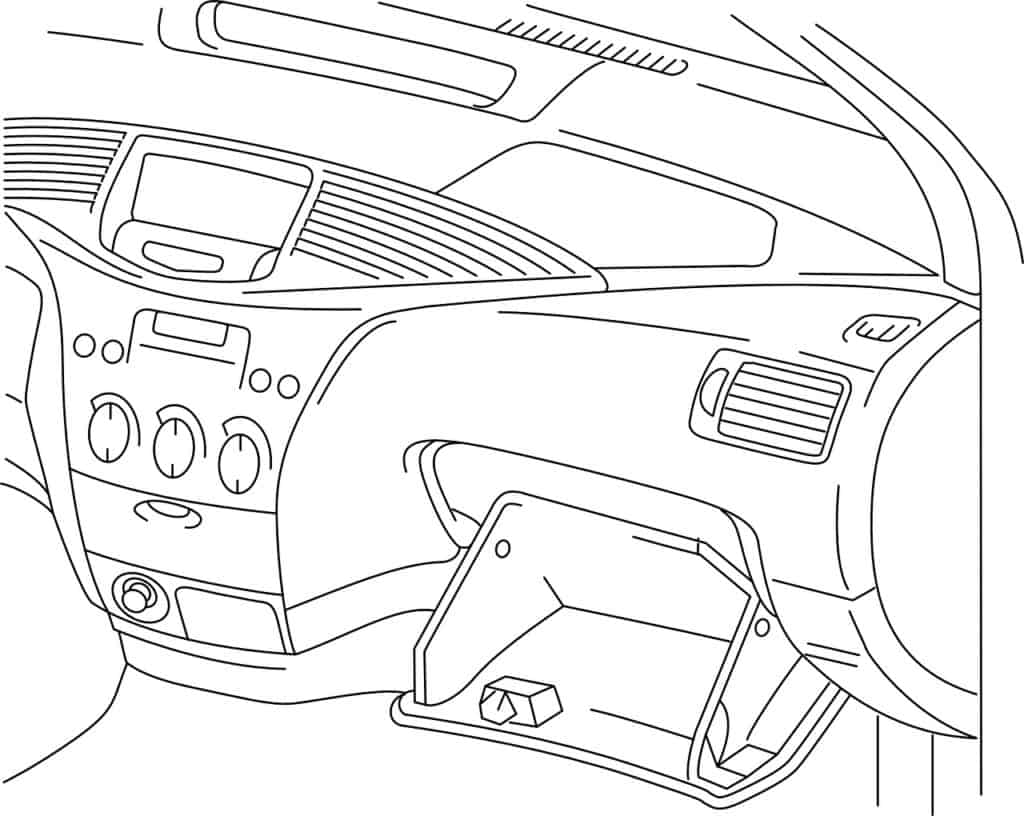
Although some glove compartments are equipped with a lock, most of them just have a latch that you need to pull down to open.
Exterior Car Parts
I know I should divide parts like interior or exterior, but I made it like that so even a rookie can learn something new about vehicles.
Hood
The car hood, also called a ”bonnet” has a purpose to cover the engine and to provide access to the engine when needed. Car hoods are usually made of steel and aluminum. It is secured by a concealed latch. To open the hood, first you need to pull the handle located on the inside the cabin on the driver’s side and then open the hood.

The car people love the hood because they can built a custom one and make their cars look sick. I mean, we all love Toretto’s hood with the engine popping up.
Windshield
The windshield has a purpose to protect the driver and the passengers from winds and all the dust, insects and rocks that the wind can carry. The windshield can be found on the front and back of the vehicle. It is sealed and no air or rain will come inside the vehicle.
When it comes to safety, when accidents happen, the windshield is built to make sure the driver and the passengers stay inside the vehicle which can most definitely save a life. It also provides support to the roof so it doesn’t collapse during an accident.
See: Top 10 Ways To Clean Your Windshield
If you notice some rain or wind coming in the vehicle, its time for a new windshield. It costs between $100-$400 to replace the windshield.
Windshield Wipers
Windshield wiper is a rubber attached to a metal structure powered by an electric motor with a task to keep the windshield clean and to remove rain by moving back and forth. A vehicle is equipped with wipers on both the front and the back windshield.
See: How Long Does Windshield Wipers Last?
You can turn on your windshield wipers by pushing the stalk on the right side of the steering wheel up or down. There are couple of speeds that you can select.
There are 3 types of windshield wiper blades:
- Conventional windshield wipers: Most commonly used windshield wipers. Have 4 to 8 pressure points to ensure best performance.
- Flat windshield wipers: More and more new cars are equipped with the flat windshield wipers. The blade exactly matches the windshield.
- Hybrid windshield wipers: A combination of the flat and conventional windshield wipers. They have the aerodynamic properties of flat windscreen wipers and the performance of the conventional windshield wipers.
Car Windows
The car windows have a purpose of protecting the driver and the passengers from wind, rain, debris and rocks that might find their way inside the car when you drive. The windows can be opened and closed by a handle located on each door or by a click of a button. Almost all newer models have electric windows.
If the window raising mechanism is faulty, the window can fall down inside the door frame. It costs from $100-$350 to repair a window, depending whats wrong with it in the first place.
There are 2 types of car windows:
- Tempered glass windows: This type of windows shatters into small pieces when an accident happens to prevent you from getting a serious injury from the sharp edges.
- Laminated glass windows: These are little bit stronger windows. They come with an layer of plastic and are little bit harder to break, but will prevent ejections from cars should an accident happen.
Car Doors
The car doors main function is to secure the vehicle and to provide access to the driver and the passengers. Each door has a lock on it which can be locked/unlocked by a unique key. Once unlocked, you need to pull the door handle to gain access. When inside, there is a door handle on the inside that you need to pull in order to get out. The car doors are located on the side of the vehicle. A single vehicle can have 2, 4 or more doors. Luxury cars are equipped with doors that open on buttons.
The doors are attached to the car by hinges and in some cases mechanism such as tracks. A complete replacement of a door can cost up to $2500.
There are 9 types of car doors:
- Regular car doors
- Butterfly doors
- Suicide doors
- Gull-wing doors
- Scissor doors
- Sliding doors
- Canopy doors
- Dihedral doors
- Swan door
Side-View Mirrors
Side-view mirror or wing mirror is a mirror that is located on the exterior side of the car doors with a purpose to help the driver see the areas behind and the side of the vehicle. It might sound simple, but without the side mirrors we won’t be able to park, or overtake vehicles efficiently.
Before driving your vehicle it is important that you adjust your side-view mirrors. Some vehicles have a small handle on the inside of the door for mirror adjustment, but on newer models you can adjust your side-view mirrors by a push of a button. A mirror replacement can cost from $200 to $1,500.
Rims
The rim is a cylindrical wheel that has a purpose to hold the tire on the wheel. Main purpose of the rim is to ensure proper fitting of the tire and rim in order to retain the air inside of the tire.
The price of the rim may vary. A standard steel rim can cost around $50 per rim. The ones used for aesthetics can cost up to $5000.
See: Can You Clean Your Chrome, Alloy And Steel Rims With Bleach
There are 4 types of rims:
- Steel rims: The steel rims are the most common rims because they are the cheapest option. The only bad thing is their weight.
- Alloy rims: The alloy rims are slowly taking over. They weight less because they are made of aluminium or magnesium.
- Chrome rims: Mostly used because of their looks and not their performance.
- Spinners: Very popular in the 90s. If you wish to leave an impression when driving, these are the right wheels for you.
Fender
The main purpose of the fender is to prevent the sand, mud, rocks and liquids spray being propelled into the air when the tire rotates. It is a part of the vehicle that gets damaged very often from all the rocks and debris hitting it. Fenders are located on top of the wheel and are attached to the vehicle body.

A fender replacement can cost from $10 to $1300 depending on the car model and make.
Bumpers
A bumper is part of a vehicle that is attached to the front and the back of the car with a main function to absorb impact in a minor accident.
Newer model cars tend to use bumpers made out of flexible materials in order to minimize injuries made to pedestrians struck by cars.
A bumper replacement can cost from $500 to $15000.

There are 5 types of bumpers:
- Standard Bumper
- Deep Drop Bumper: Mostly used on old trucks, has a heavy duty towing capacity.
- Roll Pan Bumper: Can be found on custom built trucks.
- Step Bumper: Used on higher vehicles suck as trucks, vans and SUVs.
- Tube Bumper: Mostly used on jeeps.
Grille
The main function of the grille is to allow air to enter or exit which helps with the engine temperature whilst protecting the radiator and engine from rocks and other debris. It is located on the front of the car in front of the radiator.
There are 3 types of grilles:
- Mesh Grilles: These grilles have a simple but elegant look. Many manufacturers choose to use this grille on their vehicles.
- Billet Grills: Made from aluminum and iron, they are better looking than the mesh grilles.
- CNC Grilles: Made completely by a computer. You can choose your design and the computer will do the rest.
Headlights
The main function of car headlights is to lighten up the roadway so the driver can safely drive the vehicle during the night. It is important that both of your headlights are fully functioning at all times. It’s a good idea to always keep a spare bulb in the trunk.
A headlight bulb replacement can cost anywhere from $15 to $200 depending on your car model.
See: Top 8 Ways To Clean Foggy Headlights
Having the brightest headlights can be good for you because you can see better, but on the other hand, you could be blinding the drivers coming your way. There are 4 types of headlights that you can choose from.

Over the years, the headlights have evolved and at the moment there are 4 types of headlights:
- Halogen: Most commonly used headlights in modern vehicles. Casts a yellowish light.
- LED: Same technology used on LED screen consoles. Costs more than halogen lights and has lifespan of 10,000 to 30,000 hours.
- Xenon/HID: Used on high-end vehicles. They emit bluish-white light and are very effective.
- Laser: New on the market. More efficient than LED headlights.
Turn Signal
The main function of the turn signal is to notify the other drivers when you are changing direction by flashing a yellow signal on front, side and back of the vehicle.
The turn signal is activated by pushing the turn signal lever located on the left side of your steering wheel. If you push the lever down, your left turn signal will be activated, if you push it up, the right turn signal will be activated.
The turn signal has a light bulb inside which has a lifespan of around 4000 hours. Replacement of the turn signal light bulb will cost you around $35.
Fuel System
Without the fuel, our cars won’t run. Here is how the magic happens.
Car Fuel Tank
The car fuel tank has a main function to store the fuel safely before it reaches the engine. The fuel tank is connected to a fuel pump with distributes the fuel through fuel lines and the fuel filter before reaching the engine.
The fuel tank is located beneath the car, in front of the rear axle. To add fuel to your car, simply open the fuel cap and pour fuel.
See: How To Clean A Fuel Tank Without Removing It
It’s very important to keep your fuel tank clean. When adding fuel, make sure that you don’t leave the fuel tank open for a long period of time because dirt might get in and will contaminate your fuel.
There are 2 types of car fuel tanks:
- Metal Fuel Tank: Usually found in older cars. When it comes to fuel emissions, the metal tank is very effective. The steel traps a lot of the carbon monoxide and sulfur dioxide.
- Plastic High-Density Polyethylene: Used by newer model cars. They are safer than the metal ones and have more capacity. The best thing is that plastic doesn’t corrode.
Fuel Line
The main function of the fuel line is to transport fuel from the fuel tank through the fuel filter and into the cylinder chamber where the fuel will be burned and will produce energy as a result.
The fuel line is a set of hoses that run underneath your vehicle and are connected to the fuel tank, fuel filter, fuel pump and the cylinder chamber on the engine.
If you notice fuel leak underneath your car, you should definitely get your fuel lines checked. A fully replacement of the fuel lines can cost anywhere between $120-$500.
Car Suspension
Without the suspension, every time we drive and hit a pothole, our car would simply break down. Suspension is important because it holds our car together and absorbs the shocks from the road.
Front Suspension
The front suspension main function is to keep the front tires, wheels and brakes connected and in contact with the road surface, to absorb all shock that comes from the tires and to support the weight of the vehicle.
Without the front suspension, driving would be a very unpleasant experience. The lifespan of the front suspensions depends on the roads that you drive on. If you hear some clicking sound, you better take your car to the mechanic to see what’s going on before even more damage is done.
Complete replacement of the front suspension can cost from $150-$900 depending on your car model.
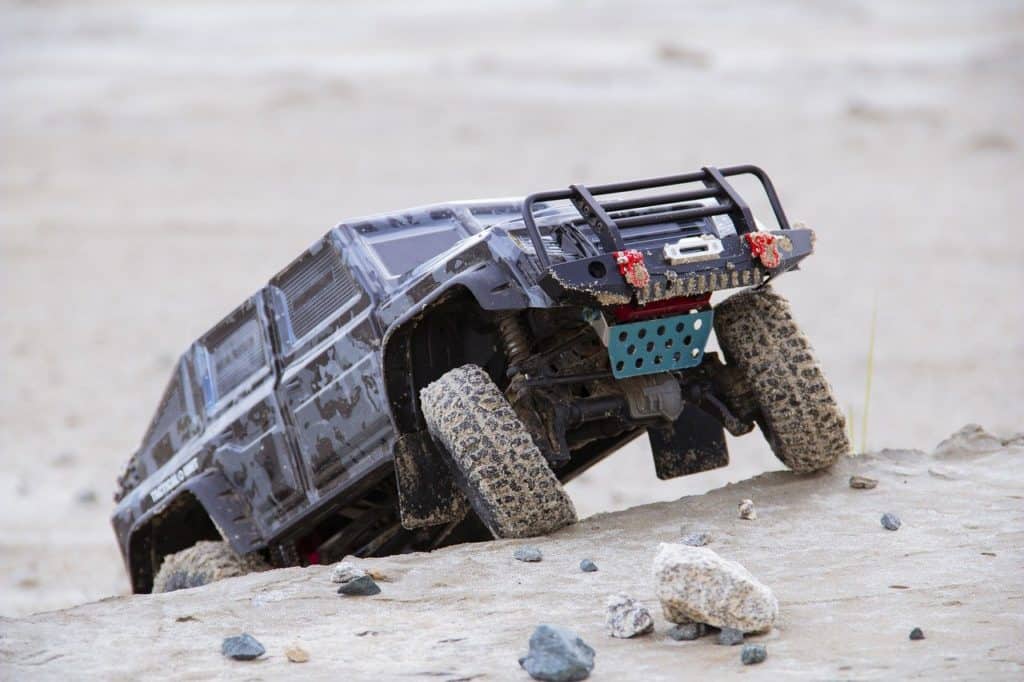
There are 3 types of front suspension:
- Coil Spring System: The weight of the vehicle is supported by coil springs.
- Torsion Bar System: The weight of the vehicle is supported by the twisting of the torsion bar.
- Conventional MacPherson Strut System: More advanced than the previous two. Basically, a combination of them both, but improved.
Rear Suspension
The main function of the rear suspension is to keep the rear tires, wheels and brakes together, to absorb all the shock coming from the tires and to support the weight of the vehicle, thus preventing the body of the vehicle from hitting the ground.
For the ultimate driving experience, it is important that your rear suspension is functioning properly. If you hear a clicking sound, make sure to take your car to the mechanic. It could be some small fix which if not attended could lead to an expensive repair.
Complete replacement of the rear suspension can cost from $200 to $1500.
The rear suspension can be depended or independent suspension. The difference between the two is that the depended suspension is connected to both rear wheels and they spin together where on independent suspension they can spin one at a time.
Exhaust System
When our engine runs, it creates a lot of toxic gases that are released into the atmosphere. Here is how the exhaust system works and how the gases change from toxic to non-toxic before they exit the tailpipe.
Exhaust
The exhaust is a set of pipes that have a function to transport toxic gasses from the engine through the exhaust system and reaching the tailpipe as a final destination. From the engine to the tailpipe, the toxic gas will be transformed into non-toxic gas thanks to the catalytic converter and will be released into the atmosphere.
A fully replacement of the exhaust can cost anywhere between $200 and $600.
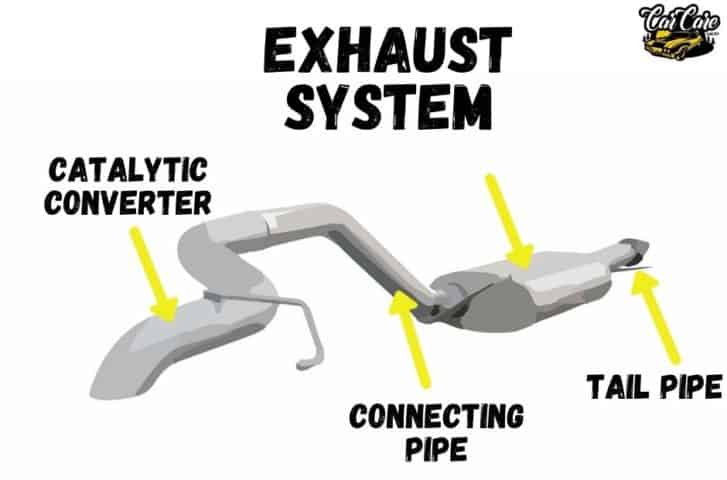
There are many types of exhausts, but here are my favorite 5:
- MagnaFlox Exhaust
- Flowmaster American Thunder Exhaust
- Heartthrob Exhaust
- Borla Exhaust
- MBRP Exhaust
Muffler
The muffler also known as silencer main function is to decrease the loud sounds coming from the engine. Every time you turn your engine on, a large amount of burnt gases created by the engine combustion are being released into the exhaust system. This process creates very loud noises which are unpleasant to the ear. This is where the muffler steps in and cancels those loud noises.
A fully replacement on the muffler can cost from $100 to $500 with labor included.

There are 4 types of mufflers:
- Straight-Through Silencers: They actually increases the horsepower of the vehicle. Very efficient at noise canceling.
- Performance Silencers: They change the sound of the car, can make it even louder.
- Multiple Baffle Silencers: This is the most effective type of silencer.
- Turbo Silencers: It is very restrictive and results in poor exhaust flow.
Exhaust Manifold
The main function of the exhaust manifold is to collect all of the gases (emission) coming from the engine. Once the gases are in the exhaust manifold and are burnt completely, the exhaust manifold sends them into the rest of the exhaust system.
A complete replacement of the exhaust manifold can cost from $150 to $1000.
There are 2 types of exhaust manifolds:
- Four Into One: Got the name by the design. It’s four pipes from the cylinder head going into one collector.
- Four Into Two Into One: Same as the previous, four pipes from the cylinder head are connected to two secondary pipes and then to a single collector.
Catalytic Converter
The main function of the catalytic converted is do convert the toxic gases created by the engine into less-toxic gasses before they are released into the atmosphere. Both gasoline and diesel cars are equipped with catalytic converter. If your catalytic converter isn’t working properly, your car won’t pass the emissions test.
The cost of an catalytic converter is between $950 to $2500.

There are 3 types of catalytic converters:
- Two-way catalytic converter: Last one was used in 1980.
- Three-way catalytic converter: Eliminates nitrogen oxide, hydrocarbons and carbon monoxide.
- Three-way plus oxidation catalytic converter: Has one extra oxidation bed that cleans the air even more.
Axle Assembly
Detailed information about the front and rear axle and the car differential.
Car Differential
The main function of the car differential as a part of the front and rear axle assembly is to provide proportional RPMs between the left and the right wheel. Our wheels are not always turning at the same speed. When going in the left corner, your left wheel will turn more than the right wheel. The differential will distribute more torque to the right wheel so it will spin as fast as the left wheel.
A full replacement of the differential could cost between $200 and $800.
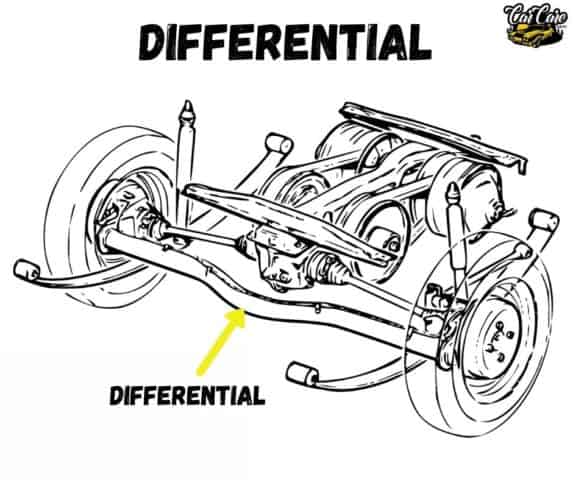
There are 4 types of car differentials:
- Open Differential: It balances the engine power in two outputs allowing the wheels to rotate at different speeds. Mostly found in family sedans and small economy cars.
- Locking Differential: The wheels will always spin at the same speed making the vehicle turning more difficult.
- Limited-slip Differential: Combination of open and locked differential. Primly it performs as an open differential but if your wheels spin, it acts as a locked differential.
- Torque-vectoring Differential: The least efficient differential. It is heavy and complex.
Front Axle
The main function of the front axle is to assist with steering and to absorb all the shock coming from the road through the tires. The front axle also carries the weight of the vehicle.
If you ever feel bad vibes, loud clanking, clicking or clunking, or you see grease leaking underneath your vehicle, your front axle might need repairs. Full replacement of the front axle can cost from $800 to $1000.
There are 2 types of front axle:
- Dead Front Axle: These axles are static and don’t rotate along with the wheels.
- Live Front Axle: Opposite from the dead front axle, the live front axle rotates and delivers power from the gearbox to the front wheels.
Rear Axle
The rear axle consists of two half-shafts that are connected by the differential and as a whole has the main function to deliver power to the driving wheels.
The rear axle connects the two rear wheels on the same axle, therefore connecting the wheels with suspension and suspension with a body.
The cost of full replacement of a rear axle can cost between $820 and $920.
There are 3 types of rear axle:
- Semi-Floating Rear Axle: Mostly used for cars, SUVs, and middle-size trucks. It is larger than other rear axle types.
- Full-Floating Rear Axle: Used for larger vehicles and heavy-duty trucks.
- Three-Quarter Floating Rear Axle: More complex. Maintains wheel alignment and produces torque.
Braking System
Once your car is running, it is important that it stops when needed.
Brake Pedal
The brake pedal is a pedal that you press in order to make your car go slower or come to a complete stop. The stopping or slowing intensity will be determined by the pressure that you apply to the brake pedal. If you push the pedal to the floor, the car will come to a complete stop.

To get more technical, pressing the brake pedal releases brake fluid that goes to the drum brake wheel cylinder and activates two small pistons that squeeze the brake shoes against the brake drum which slows the wheel down.
Brake Pads
The brake pad’s main function is to apply pressure and friction to the brake rotors which results in the car slowing down – braking. Every time you hit the brake pedal you are making the brake pads contact the braking rotor, therefore, slowing your vehicle.
See: Why Are My Brakes Making Noise?
Every time the braking pads are in a contact with the braking rotor, they are slowly wearing down. It is important to regularly change your brake pads to make sure that your brakes are working properly. The brake pads cannot be repaired, so changing them will cost you between $200 and $250.
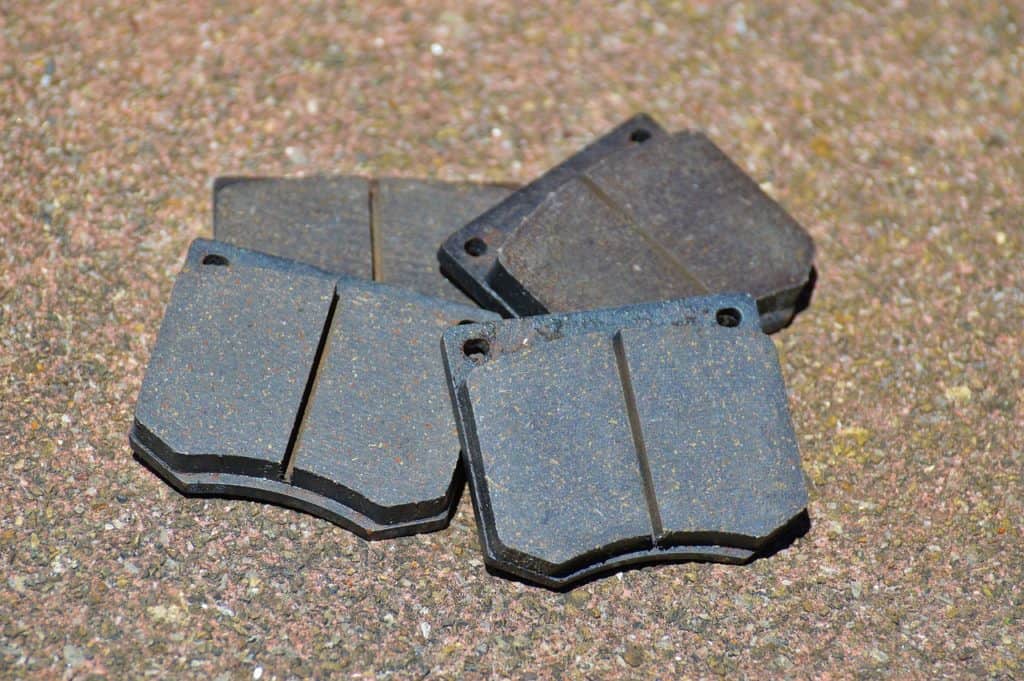
There are 3 types of brake pads:
- Organic Brake Pads: They are made from asbestos which is a carcinogen material. That’s enough information to stay away from them.
- Ceramic Brake Pads: Efficient. They create no additional noise when braking. However, they are more expensive than organic brake pads.
- Metallic Brake Pads: Mostly used by high-performance cars.
Emergency Brake
Emergency brake (e-brake), also known as the parking brake or hand brake has a function to keep your vehicle motionless when parked. Whenever the car is parked, especially an automatic car, it is important to apply the emergency brake to make sure that your car will stay in that position.
You shouldn’t apply the emergency brake when driving because the vehicle might flip. It should be only used if your braking system fails and you have no other way of stopping your vehicle.
The emergency brake is directly connected to the rear brakes. Anytime you apply the emergency brake, you are activating the rear brakes and they will stay locked as long as the e-brake is applied.
There are 4 types of emergency brakes:
- Stick lever e-brake: Used mostly by older model cars, can be found under the instrument panel.
- Center lever e-brake: Most commonly used e-brake. Can be found between the driver’s and passenger seat.
- Pedal e-brake: Found on the far-left side of the floor pedals. Mostly used on cars with automatic transmission.
- Push button e-brake: Found in newer models. Can be found around the gearshift.
Brake Discs
The main function of the brake disc is to squeeze the brake pads against a disk with the help of calipers, therefore creating a braking force which will slow down or stop your vehicle.
Because of the constant friction that the disc endures, eventually they wore out. A new disc can cost anywhere from $160 to $220.
When you hear a squeaking sound every time you brake, that means that the braking pads are completely worn out and braking force is applied directly to the disc.
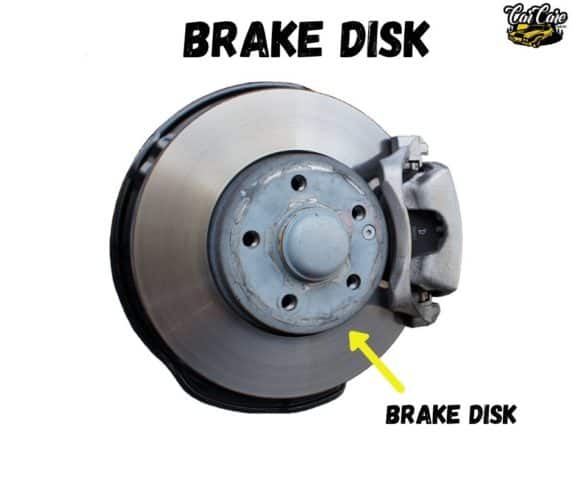
There are 7 types of brake discs:
- Vented Brake Disc:Two discs combined together with some gaps between them to vent the heat faster.
- Drilled Brake Disc: The heat is released through the drilled holes on the brake disc surface.
Brake Caliper
The brake caliper main function is to press the brake pads against the brake disc which creates a braking power and your vehicle will slow down or stop. Brake caliper is triggered when you press the brake pedal.
The brake caliper houses the brake pads and is connected to the master cylinder via hydraulic hoses that provides the braking fluid.
Full replacement of the brake calipers can cost from $700 to $1500.
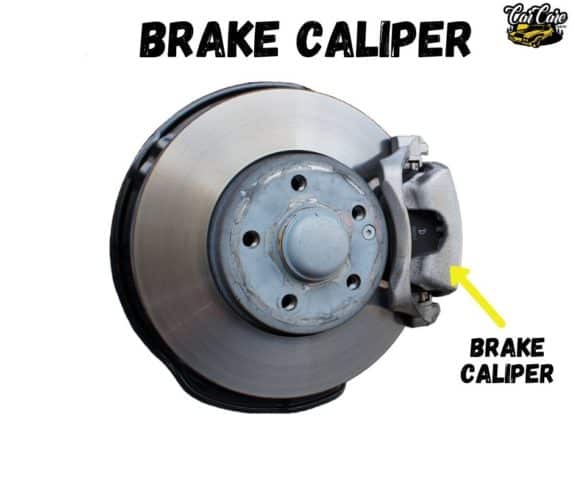
There are 3 types of brake calipers:
- Floating Calipers: Has pistons on only one side acting as a clamp.
- Sliding Calipers: More improved version of the floating calipers, works on the same principle.
- Fixed Opposed Piston Calipers: Has 2,4,6 or 8 pistons. Has better performance but costs more.
Hydraulic Lines
The hydraulic lines is a set of hoses that are connected together and form a circle with main function to transfer brake fluid from the main cylinder into the braking system.
Basically, when you press the brake pedal, a fluid is released from the master brake cylinder and travels into the hydraulic lines to the brake calipers where braking force is created.
The hydraulic brake lines could be made from metal or PVC.
Master Brake Cylinder
The master brake cylinder has a function to convert pressure created by pressing the brake pedal into hydraulic pressure by supplying brake fluid into the braking system therefore creating a braking power.
Basically, once you press the brake pedal, braking fluid is released from the master cylinder and is transferred to the brake caliper via the hydraulic lines.
Complete replacement of the master braking cylinder will cost anywhere between $320 and $500.
There are 3 types of master brake cylinders:
- Single Brake Cylinder: The most basic type of master brake cylinder. Many race car builders prefer it.
- Ported Tandem Cylinder: Has two pistons in one.
- Portless Master Cylinder: Quicker brake release because it has no compensating port.


Leave a comment